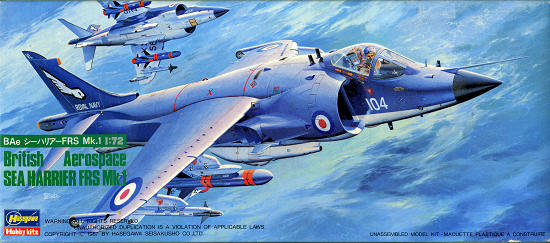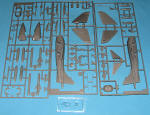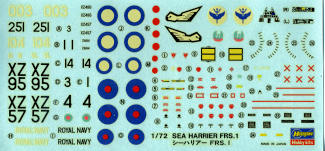
Hasegawa 1/72 Sea Harrier FRS.1
| KIT #: | 606 |
| PRICE: | $9.95 |
| DECALS: | Four options |
| REVIEWER: | Scott Van Aken |
| NOTES: | 1986 Boxing |

| HISTORY |
The BAE Systems Sea Harrier is a naval VTOL/STOVL jet fighter, reconnaissance and attack aircraft, a development of the Hawker Siddeley Harrier. It first entered service with the Royal Navy in April 1980 as the Sea Harrier FRS1. The last version was the Sea Harrier FA2. Informally known as the "Shar", the Sea Harrier was withdrawn from Royal Navy service in March 2006 and replaced by the Harrier GR9.
Sea Harriers took part in the Falklands War of 1982, flying from the aircraft carriers HMS Invincible and HMS Hermes. The Sea Harriers were to operate in their primary air defense role with a secondary role of ground attack, with the RAF Harrier GR3 providing the main ground attack force. The Sea Harrier squadrons shot down 21 Argentine aircraft in air-to-air combat with no air-to-air losses, although two Sea Harriers were lost to ground fire and four to accidents.
A number of factors contributed to the failure of the Argentinean fighters to shoot down a Sea Harrier. Although the Mirage III and Dagger jets were considerably faster, the Sea Harrier was more maneuverable. Moreover, the Harrier employed the latest AIM-9L Sidewinder missiles and the Blue Fox radar. The British pilots had superior air-combat training, one manifestation of which was that they noticed Argentinean pilots occasionally releasing weapons outside of their operating parameters. Mirages released external fuel tanks (not weapons) and turned away from conflict with the Sea Harrier. This later reduced their capability to fight an effective campaign against the Sea Harrier due to reduced range.
British aircraft received fighter control from warships in San Carlos Water, although its effectiveness was limited by their being stationed close to the islands, which severely limited the effectiveness of their radar.
Both sides' aircraft were operating in adverse conditions. Argentine aircraft were forced to operate from the mainland because airfields on the Falklands were only suited for propeller-driven transports. In addition, fears partly aroused by the bombing of Port Stanley airport by a British Vulcan bomber added to the Argentineans' decision to operate them from afar. As most Argentine aircraft lacked in-flight refueling capability, they were forced to operate at the limit of their range. The Sea Harriers also had limited fuel reserves due to the tactical decision to station the British carriers out of Exocet missile range and the dispersal of the fleet. The result was that, although an Argentine aircraft could only allow five minutes over the islands to search and attack an objective and without any capable air-to-air missile, a Sea Harrier could stay near to 30 minutes waiting in the Argentine approach corridors.
The Sea Harriers were outnumbered by the available Argentinean aircraft and were on occasion decoyed away by the activities of theEscuadrón Fénix or civilian jet aircraft used by the Argentine Air Force. They had to operate without a fleet early warning system such as AWACS that would have been available to a full NATO fleet in which the Royal Navy had expected to operate.
The result was that the Sea Harriers could not establish complete air superiority and prevent Argentine attacks during day or night, nor could they stop the daily C-130 Hercules transports' night flights to the islands. A total of six Sea Harriers were lost to either ground fire, accidents or mechanical failure during the war.
| THE KIT |
 The date on the instructions is 1986 and looking at the nicely engraved panel lines, this is one of Hasegawa's earlier engraved kits. Typical of Harrier kits, the nose section is separate from the rest of the fuselage and there are no hold-downs to allow for the swiveling of the nozzles. Having said that, the spaces are usually tight enough so they don't have to be glued down allowing you to move them if you wish. Hasegawa has made an attempt at providing the upper bleed in doors at the relaxed position as they would normally be, though they seem to lack crispness on the edges.
The date on the instructions is 1986 and looking at the nicely engraved panel lines, this is one of Hasegawa's earlier engraved kits. Typical of Harrier kits, the nose section is separate from the rest of the fuselage and there are no hold-downs to allow for the swiveling of the nozzles. Having said that, the spaces are usually tight enough so they don't have to be glued down allowing you to move them if you wish. Hasegawa has made an attempt at providing the upper bleed in doors at the relaxed position as they would normally be, though they seem to lack crispness on the edges.
Typical of their 1/72 kits, all the instruments and consoles are provided as decals. A rather generic looking bang seat and a pilot are part of the deal for the interior. Tail planes are notched so that they may be mated together through the fuselage and allowed to move. The kit provides the option of strakes or guns for under the fuselage. Gear doors are molded shut as they normally are on the ground with only the small ones on the landing gear left open. The speed brake may be positioned as lowered if one wishes. There are Sidewinders, Sea Eagles, and bombs to put on the racks as well as drop tanks, so your Sea Harrier will be well outfitted. A refueling boom is also provided, but not always carried so it is your choice.
 Instructions provide Gunze references and markings for four aircraft. Two are in the box art scheme of Extra Dark Sea Grey over White and with 899 and 801 NAS. The other two are from the Falklands conflict. one from what is listed as 899 NAS aboard the Hermes in overall Extra Dark Sea Grey and the other from 809 NAS aboard the Illustrious in a more medium grey scheme that is attained by mixing paints. Decals are well printed, thick and have whites that are really off white. I'm sure that even at this late date they are viable, but there are also many aftermarket sheets that can be used for this kit. A full stencil suite is also provided.
Instructions provide Gunze references and markings for four aircraft. Two are in the box art scheme of Extra Dark Sea Grey over White and with 899 and 801 NAS. The other two are from the Falklands conflict. one from what is listed as 899 NAS aboard the Hermes in overall Extra Dark Sea Grey and the other from 809 NAS aboard the Illustrious in a more medium grey scheme that is attained by mixing paints. Decals are well printed, thick and have whites that are really off white. I'm sure that even at this late date they are viable, but there are also many aftermarket sheets that can be used for this kit. A full stencil suite is also provided.
| CONCLUSIONS |
When it comes to Sea Harriers in 1/72, I can only think of this one and the slightly older ESCI version (probably reboxed by Italeri and others) when we want an FRS.1. Both kits are still nice builds and since this is one of Hasegawa's standard kits, it is still relatively inexpensive. (Late note: I have been reminded that Fujimi and Matchbox also did a Sea Harrier. Thanks Shervin)
| REFERENCES |
http://en.wikipedia.org/wiki/Sea_Harrier
November 2009 If you would like your product reviewed fairly and fairly quickly, please contact the editor or see other details in the